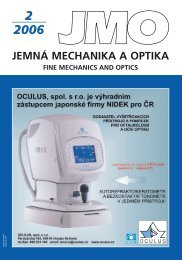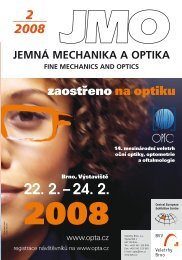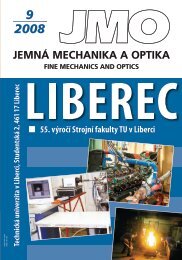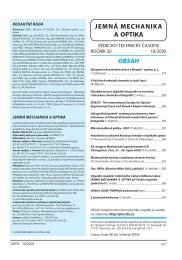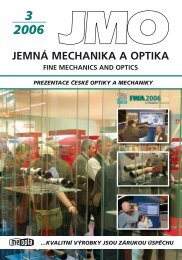technická univerzita v liberci fakulta strojní - Jemná mechanika a ...
technická univerzita v liberci fakulta strojní - Jemná mechanika a ...
technická univerzita v liberci fakulta strojní - Jemná mechanika a ...
Create successful ePaper yourself
Turn your PDF publications into a flip-book with our unique Google optimized e-Paper software.
72<br />
Fig. 2 Schematic of the cardboard fixture for single (carbon)<br />
filament testing<br />
2.4. Surface characterization - Morphological analysis using<br />
SEM<br />
Scanning electron microscopy (SEM) (JEOL, model 840)<br />
with 10,000 times magnification was employed to characterize<br />
the morphological changes on the fiber surfaces of untreated and<br />
treated carbon fibers. The samples were coated with a conducting<br />
material (gold) prior to examination.<br />
3. RESULTS AND DISCUSSION<br />
3.1. Tensile strength tests<br />
3.1.1. Plasma treatment<br />
Table 1 shows the average tensile strength values of sized<br />
carbon fibers untreated and treated, respectively, with argon and<br />
oxygen plasmas. It shows significant differences in the tensile<br />
strength of as-received carbon fibers and fibers subjected to argon<br />
plasma treatments for 10 and 20 minutes. The higher tensile<br />
strength of the sample treated by argon plasma for 10 minutes was<br />
attributed to the removal of the outermost layer of the carbon fiber<br />
surface. This procedure contributed to decrease the critical flaw<br />
size population that acts as a stress con centrator, contributing to<br />
reduce the fiber’s strength [9]. The 20 minutes argon plasma treatment<br />
resulted in lower tensile strength than that of untreated fiber.<br />
This reduction was attributed to the longer treatment time (from<br />
10 to 20 minutes) which led to the formation of deeper crevices<br />
and pitting on the carbon surface, thereby further reducing the<br />
fiber’s tensile strength.<br />
Table 1 also indicates that the tensile strength of carbon fibers<br />
treated with oxygen plasma decreased more than that of fibers<br />
treated with argon plasma. A comparison of the average tensile<br />
strength of treated and untreated samples reveals that this property<br />
decreased by 11.8% in the samples treated for 2 minutes and by<br />
73.4% in those treated for 10 minutes. The carbon fiber’s weight<br />
measured before and after argon plasma treatments indicated<br />
a post-treatment weight loss of around 1.2%, while losses of up to<br />
4.9% were observed after oxygen plasma treat ments. These results<br />
indicate that a progressive weight loss occurred with CO 2 evolution<br />
[10], suggesting that active site atoms on the fiber surface were<br />
oxidized to form oxygen-containing surface groups such as C-OH,<br />
C=O, COOH and finally CO 2 [6].<br />
3.2. Surface characterization - SEM observations<br />
The carbon fiber surfaces were observed by SEM and involved<br />
the following carbon fiber samples: as-received carbon fiber, fiber<br />
treated by argon plasma for 10 minutes and by oxygen plasma for<br />
2 minutes. These samples were chosen for a more detailed analysis<br />
because these treatments heighten the probability of introducing<br />
polar groups and modifying the roughness of carbon fiber surfaces.<br />
Figure 3a shows a SEM image of an as-received carbon fiber sample.<br />
As expected, this fiber’s relative smoothness was attributed to<br />
the wet spinning process employed to produce the polyacrylonitrile<br />
(PAN) filaments used as raw material in carbon fiber processing<br />
[10]. Figure 3b shows a micrograph representative of the carbon<br />
fib er treated with argon plasma for 10 minutes, indicating that<br />
the argon plasma treatment increased the superficial roughness.<br />
A comparison of the SEM findings and the tensile strength results<br />
Fig. 3a<br />
Fig. 3b<br />
Table 1 Tensile strength (s) of carbon fiber samples untreated and treated with argon and oxygen plasmas<br />
Oxygen Plasma Treatment s [MPa] Argon Plasma Treatment s [MPa]<br />
as-received fiber 2 minute 5 minutes 10 minutes 10 minutes 20 minutes<br />
1968 ± 438 1735 ± 510 1423 ± 431 523 ± 311 2468 ± 445 1786 ± 493<br />
3/2007



